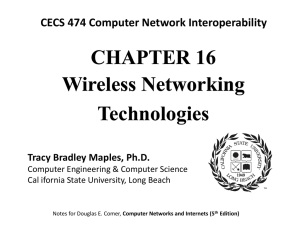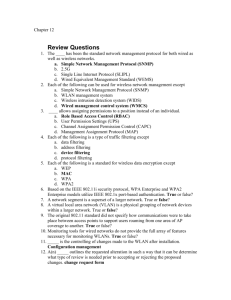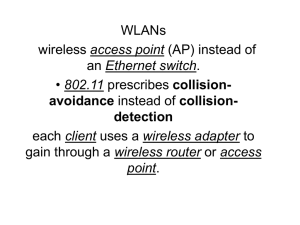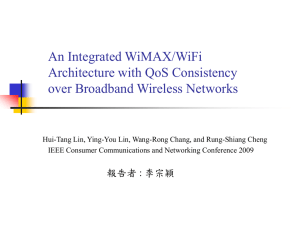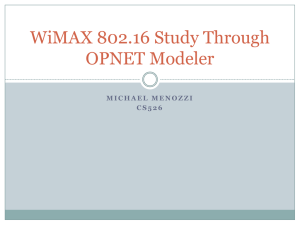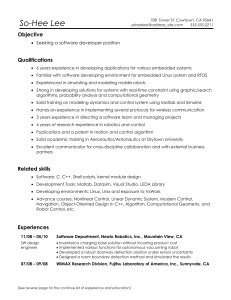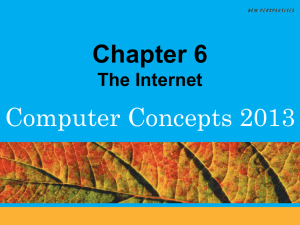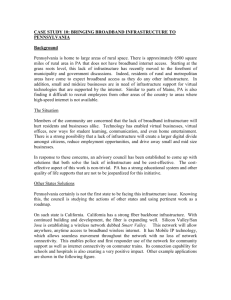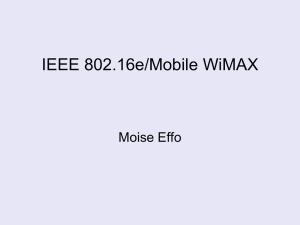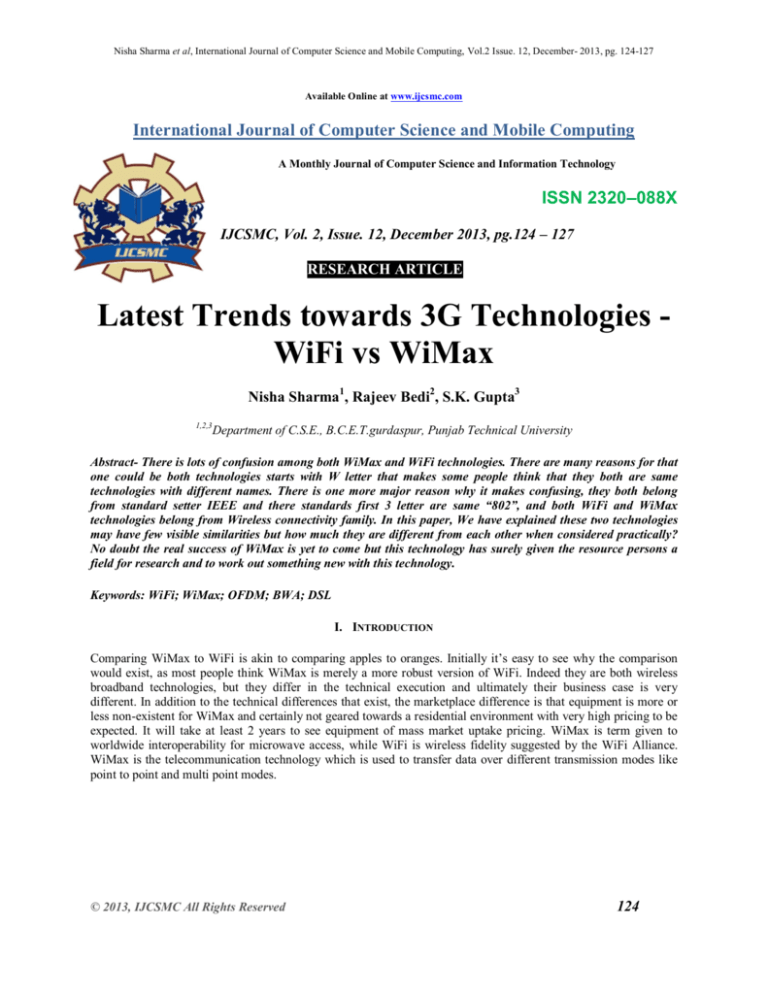
Nisha Sharma et al, International Journal of Computer Science and Mobile Computing, Vol.2 Issue. 12, December- 2013, pg. 124-127
Available Online at www.ijcsmc.com
International Journal of Computer Science and Mobile Computing
A Monthly Journal of Computer Science and Information Technology
ISSN 2320–088X
IJCSMC, Vol. 2, Issue. 12, December 2013, pg.124 – 127
RESEARCH ARTICLE
Latest Trends towards 3G Technologies WiFi vs WiMax
Nisha Sharma1, Rajeev Bedi2, S.K. Gupta3
1,2,3
Department of C.S.E., B.C.E.T.gurdaspur, Punjab Technical University
Abstract- There is lots of confusion among both WiMax and WiFi technologies. There are many reasons for that
one could be both technologies starts with W letter that makes some people think that they both are same
technologies with different names. There is one more major reason why it makes confusing, they both belong
from standard setter IEEE and there standards first 3 letter are same “802”, and both WiFi and WiMax
technologies belong from Wireless connectivity family. In this paper, We have explained these two technologies
may have few visible similarities but how much they are different from each other when considered practically?
No doubt the real success of WiMax is yet to come but this technology has surely given the resource persons a
field for research and to work out something new with this technology.
Keywords: WiFi; WiMax; OFDM; BWA; DSL
I. INTRODUCTION
Comparing WiMax to WiFi is akin to comparing apples to oranges. Initially it’s easy to see why the comparison
would exist, as most people think WiMax is merely a more robust version of WiFi. Indeed they are both wireless
broadband technologies, but they differ in the technical execution and ultimately their business case is very
different. In addition to the technical differences that exist, the marketplace difference is that equipment is more or
less non-existent for WiMax and certainly not geared towards a residential environment with very high pricing to be
expected. It will take at least 2 years to see equipment of mass market uptake pricing. WiMax is term given to
worldwide interoperability for microwave access, while WiFi is wireless fidelity suggested by the WiFi Alliance.
WiMax is the telecommunication technology which is used to transfer data over different transmission modes like
point to point and multi point modes.
© 2013, IJCSMC All Rights Reserved
124
Nisha Sharma et al, International Journal of Computer Science and Mobile Computing, Vol.2 Issue. 12, December- 2013, pg. 124-127
II. RADIO TECHNOLOGY
Besides the obvious difference in transmission range, there are a number of improvements in the radio link
technology that distinguish WiMax from WiFi. The IEEE 802.11 wireless LAN standards describe four radio link
interfaces that operate in the 2.4 G or 5 GHz unlicensed radio bands; the four are summarized in Table 1. The
WiMax standards include a much wider range of potential implementations to address the requirements of carriers
around the world. The original version of the 802.16 standard released in December 2001, addressed systems
operating in the 10- 66 GHz frequency band. Those high-frequency systems require line-of-sight (LOS) to the base
station, which increases cost and limits the customer base. Further, in line-of-sight systems, customer antennas must
be realigned when a new cell is added to the network. We will focus primarily on the 802.16a standard released in
January 2003 that describes systems operating between 2 GHz and 11 GHz. The lower frequency bands support
non-line-of-sight (NLOS), eliminating the need to align the customer unit with the base station
© 2013, IJCSMC All Rights Reserved
125
Nisha Sharma et al, International Journal of Computer Science and Mobile Computing, Vol.2 Issue. 12, December- 2013, pg. 124-127
III. WIFI VS WIMAX RANGE
The range of WiFi over antenna is 32 meters for indoor networks and 95 meters for outdoor networks. However this
range is correlated to the frequency band. It is said that the WiFi with frequency range in 5 GHz is lower in
performance as compared to the 2.4 GHz frequency range. However this range can be improved using wireless
routers and antennas situated at a distance of few kilometers. As compared to the WiFi, WiMax covers the much
greater range. WiMax can operate on the range of frequencies from 2.3 GHz to 3.5 GHz. Hence a wireless WiMax is
capable of covering an area range of up to 10miles.WiMax is also subject to provide the broadband speed of more
than 10Mbps.WiFi is applied to OFDM while WiMax is making use of an extended version of OFDM and that is
scalable orthogonal frequency division multiple access. WiMax is what is known as a Metropolitan Area Network
(MAN), which basically means that it is designed to provide wireless network coverage to a metropolitan area. One
WiMax access point has a rough signal range of anything from 3 miles to 30 miles (even more depending on who
you talk to). Compare that to WiFi, which is a Local Area Network (LAN) and designed to provide coverage to a
local area with a range of only a few hundred meters at best.
IV. SPEED
WiMax’s capability of transferring data at speeds of up to 75 Megabits per second (Mbps), as opposed to WiFi’s
broadband speeds of around 1.5Mbps and you can start to see why there is a growing buzz in the wireless industry
for WiMax. Not only does WiMax offer faster speeds and wider coverage than WiFi, it also offers a better quality of
connection. WiFi connections are constantly competing with one another to connect to the wireless network – you
may have seen people in hotel lobbies or cafes moving their laptops around in peculiar ways trying to get a stronger
wireless signal to connect to. WiMax users only need to connect once to the network and they get an allocated
amount of bandwidth to use that remains constant as long as the user stays connected to the network. WiMax works
at a higher frequency than WiFi and as such is able to offer higher data transfer speeds and Quality of Service. It is
able to use licensed frequencies between 2GHz and 11GHz (WiFi uses 2.4GHz and 5GHz) and even unlicensed
frequencies up to 66GHz (In the realm of Television signals).
V. COST
If try to compare the cost and effectiveness of both wireless technologies we shall end up rating WiMax high. WiFi
is considered to be the end users technology while the expense of WiMax has limited its use. WiMax technology
was not very popular even after 2006. This was due to the controlled commercial availability and standardization
concerns. The major businesses make use of it, because it replaced major technologies like DSL and repeaters.
WiMax is still unable to replace the small commercial networks and home based networks because WiFi are much
swift and reliable. WiFi is the need and demand of hotspots, and it is hard for the WiMax to substitute it. The reason
it that people are more used to the WiFi technology and they are now trained to use this technology. Switching to
WiMax is not only expensive but also need expertise to use the WiMax technology. The expense of WiMax
technology doubles when it is hard to find the equipments and machinery compatible to work with WiMax
technology. If we do a market survey for wireless technologies, we would find that most of the mobile equipments
like smart phones, laptops and palm tops are loaded with WiFi components at large. WiFi technology is more
conform to the IEEE802.11 standards. Hence this is the reason why PDAs and other digital devices nowadays must
possess the WiFi components. WiMax conform to 802.16 IEEE standards.
VI. WIMAX/WI-FI MARKET O VERVIEW
The most fundamental difference between WiMax and Wi-Fi is that they are designed for totally different
applications. Wi-Fi is a local network technology designed to add mobility to private wired LANs. WiMax, on the
other hand, was designed to deliver a metro area broadband wireless access (BWA) service. The idea behind BWA
is to provide a fixed location wireless Internet access service to compete with cable modems and DSL. So, while
Wi-Fi supports transmission ranges up to a few hundred meters, WiMax systems could support users at ranges up to
30 miles. This difference in focus helps to explain why there has been less “market buzz” surrounding WiMax.
Where Wi-Fi marketing targeted the end user, WiMax is intended as the basis of a carrier service. As a result, the
WiMax Forum has been working primarily with component and equipment suppliers to develop base stations and
© 2013, IJCSMC All Rights Reserved
126
Nisha Sharma et al, International Journal of Computer Science and Mobile Computing, Vol.2 Issue. 12, December- 2013, pg. 124-127
premises equipment that carriers will use to deliver the service. The market view of WiMax has also been confused
by the range of applications for which it has been proposed. According to Margaret LeBrecque, Marketing Manager
for the Broadband Wireless Division at Intel Capital, and former president of the WiMax Forum, three major phases
in development are anticipated:
* Phase 1--Fixed Location Private Line Services or Hot Spot Back-haul
* Phase 2--Broadband Wireless Access/Wireless DSL:
* Phase 3- Mobile/Nomadic Users:
References:
[1]. Zakhia Abichar, Yanlin Peng, and J. Morris Chang, WiMax: The Emergence of Wireless Broadband, IEEE IT professional, Volume: 8,
Issue: 4, July-Aug 2006, Pages: 44 – 48.
[2] Michael F. Finneran, “WiMax versus Wi—FI A comparison of Technologies, Markets and Business Plan”, dBrn Associates, Inc,
http://www.searchnetworking.techtarget.com/searchNetworking/downloads/Finneran.pdf, last visited February 20, 2007.
[2] D. P. Hole and F. A. Tobagi, “Capacity of an IEEE 802.11b wireless LAN supporting VoIP,” in Proc. IEEE ICC, Jun. 2004, vol. 1, pp. 196–
201.Goode B., September 2002. Voice Over Internet Protocol (VoIP). Invited Paper. Proceedings of the IEEE, Vol. 90, no. 9.
[3] B. Teitelbaum, "Leading-edge voice communications for the MITC," Sept. 12, 2003 at http://people.internet2.edu/~ben/.
[4] Forman, G. 2003. An extensive empirical study of feature selection metrics for text classification. J. Mach. Learn. Res. 3 (Mar. 2003), 12891305.
[5] J. C. Bellamy, Digital Telephony, John Wiley & Sons, 2000.
[6] T.S. Rappaport, Wireless Communications: Principles and Practice, Prentice Hall, second edition, 2002.
[7] ISO/IEC and IEEE Draft International Standards,"Part 11: Wireless LAN Medium Access Control (MAC) an Physical Layer (PHY)
Specifications," ISO/IEC 8802-11, IEEE P802.11/D10, Jan. 1999.
[8] F. Anjum, M. Elaoud, D. Famolari, A. Ghosh, R. Vaidyanathan, A. Dutta, P. Agrawal, T. Kodama, and Y. Katsube. Voice performance in
WLAN networks-an experimental study. Global Telecommunications Conference, 2003. GLOBECOM’03. IEEE, 6, 2003.
[9] S. Garg and M. Kappes. An experimental study of throughput for udp and voip traffic in ieee 802.11b networks. Wireless Communications
and Networking, 2003. WCNC 2003. 2003 IEEE, 3:1748–1753 vol.3, 16-20 March 2003.
[10] IEEE standard for local and metropolitan area networks, Part 16: Air Interface for fixed broadband wireless access systems, IEEE Standard
802.16, October 2004.
[11] Goode B., September 2002. Voice Over Internet Protocol (VoIP). Invited Paper. Proceedings of the IEEE, Vol. 90, no. 9.
© 2013, IJCSMC All Rights Reserved
127

